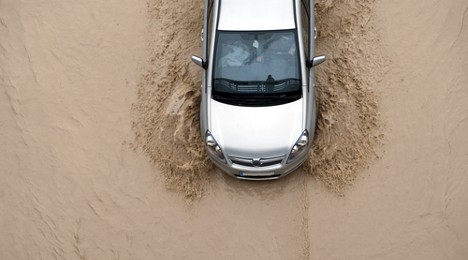How dealers avoid flood-damaged vehicles

There’s quite a bit of hubbub being made in the consumer-facing media following the recent flooding in Texas and the vehicles that suffered water damage.
The National Insurance Crime Bureau, based on estimates from Copart, recently reported that the fallout from the flooding affected between 7,000 and 10,000 insured vehicles in the area. While the majority of media is focused on warning consumers, this feature will hone in on protecting auctions and dealers alike.
There is a good chance that there will be folks who try to trade in a flood-damaged vehicle or that many of these cars may end up at the auction. But through Auto Remarketing’s recent conversations with dealers around the country, it seems there are a variety of ways for the industry to handle this challenge.
Dealers we’ve reached out to, from both coasts and even in the heart of our automotive industry in Michigan, have said they haven’t seen any impact in trade-ins or in the lanes from the recent Texas floods.
At least not yet.
One such dealer, who is intimately familiar with flood-damaged vehicles, is Frank Fuzy, owner of Century Motors of South Florida in Pompano Beach, Fla.
Positioned near the coast of the Sunshine State and less than an hour’s drive from Miami, Fuzy — with 31 years of automotive sales in both retail and wholesale settings — is no stranger to identifying the negative effects of water on vehicles.
“It would be pretty obvious if you had any more than a foot of water in a car,” Fuzy said. “I’m sure when the floods hit, it was probably that brown Texas color so I’m sure it would be excessively stained. I’ve seen some flood cars down when the hurricanes hit the Keys, and I’ve seen where I’ll have shells in the engine blocks in a Toyota or something. You can see the rust line and the water line, and fair enough, you can check under the seats, and they’re all rusty, too.”
One pro tip that Fuzy provides is simple: check the seat tracks to see if they will move.
“Those seat tracks will freeze up pretty quick if they’ve been wet,” Fuzy said. “So that’s usually a good tell-tale.”
Fuzy, although not worried about the potential threat, knows better than to not expect the unexpected, even though he hasn’t seen any sign of flood-damaged vehicles recently.
Fuzy said, “It’s probably that it’s not a real issue for us now, but it’s definitely good to watch out for.”
For any vehicle that has been mostly or completely submerged, Fuzy says it’ll be pretty obvious that you need to avoid it.
“A fully submerged car, if it was ever wet, I could smell it probably without even opening the door,” Fuzy said. “Those should be pretty easy to detect. The second item is if it’s submerged up to the seat lines — usually, if the power seats don’t work, that should be a red flag. There’s no reason the power seats wouldn’t work in the car unless it went under water and the modules got wet.”
Although a vehicle may have some flood damage, the extent of the damages may not mean the vehicle is a complete wash, so to speak.
“I have had Corvettes come in, they sit low, and I have seen wet seat tracks,” Fuzy said. “But the extent of the water in the car was about an inch or two, not like a foot underwater, so all the computer stuff works. It just depends on how you evaluate a flood car.”
On the West Coast at Capistrano Volkswagen in San Juan Capistrano, Calif., you’ll find Harry Haber, the dealership’s used-car manager.
Haber, whom we spoke with toward the begging of June, is approaching the situation with a conservative mindset, even though he hasn’t personally seen any flood-damaged vehicles in about a year.
“Anything from the Texas area, presently, if I see a registration or a prior history that a car was in the state of Texas I’ve been kind of shying away from those cars unless they’re from a financial consignment lane,” Haber said.
“Today I was previewing some cars and they had Texas registrations on them here in the state of California,” Haber continued. “They’re at the auctions. I marked ‘no interest’ on them.”
Blaine Marston, the general manager of the CARite location in Monroe, Mich., echoed a similar message.
“We have not seen any flood vehicles,” Marston said. “If discovered, we would not retail a flood-damaged vehicle.”
To recap, here are just a few spots recommended to check for flood damage:
- Seat tracks: Do they move? Are they rusty? Check the bolts on the rails and look under any caps — if the bolts are rusty, the vehicle may have previously been involved in a flood. If the vehicle has power seats, do they function?
- Engine bay and exterior: Are there water lines anywhere in the engine compartment or on the outside body/inside the fender wells? Rust lines? Unusual debris?
- Interior smell: Does the vehicle have a musty odor? Is any of the interior upholstery discolored or look unusually new or replaced
And for more tips on flood damage from the auction side of things, be sure to check the information on auction standards and various other resources available through the National Auto Auction Association website.


